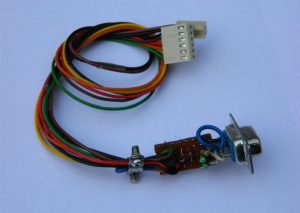So far I’ve discussed about the micro controller basics and the compiler software. I’ve yet not written anything about programming.
ATmega32 series micro controllers support 3 types of programming
- Parallel Programming
- ISP Programming or serial Programming
- Programming via JTAG
Here ISP stands for In System Programmer. To burn a micro controller just the burning Hardware is not enough, it requires software also that would download the program present in a computer or memory device into the micro controller.
Now the software which I am talking about is named PONY PROGRAMMER 2.06. My circuit is adapted from the website of Pony Programmer. It uses PC COM PORT to download the program into the micro controller. It has a signal amplitude of +5 to +12 volt representing binary ‘1’ and -5 to -12 representing ‘0’.
The micro controller, ATmega32 is programmed using the pins meant for SPI communication. To enable programming, the microcontroller must be taken to the RESET state by pulling its reset pin LOW (Logic 0, or say 0 V). In this state, microcontroller is programmable in either mode (Parallel programming or serial programming). Micro controller always accepts 0 V as logic 0 and +5 V as logic one.
The signals transmitted from PC is not in a form that could be accepted directly by the micro controller. Those signals from PC should be made suitable for micro controller. In the programmer, Zener diodes provide necessary conditioning for the signals. It is wired in such a way that it converts ±12 volt signal to +5-0 volt signal which is suitable for the micro controller. A resistance is necessary to limit the current in the nodes of Zener diodes, without the which the Zener diode may burn off. And computer internal circuits may also receive harms.
A high signal (+5V) in the ‘Reset’ pin of micro controller brings it into operational state. A low signal (Ground) drives it into programming mode. Internal pull up resistors are provided at the reset pins and if nothing is connected to this pin, the micro controller tries to execute the program written within it. Designers can provide a resistance capacitance reset circuit, but it’s not always necessary. Whatever, a push button is used in most cases to provide reset facility. Here in the burner circuit an open collector output is provided to the reset pin and it is driven by the programmer through the port. This much is enough.
The necessary data transmission and reception work portion is handled by the pony programmer. Follow the links provided to download pony programmer. The following burner circuit can burn ATmega32 microcontroller. Connect the derived signals to the adjacent pins, attach the cable to com port, power up the device i.e. micro controller, and the micro controller is ready to be programmed.
ISP Programmer Circuit Diagram
So that is how the circuit is set up. Now let me tell you that the micro controller runs upon the internal calibrated RC oscillator in the pictures. So that there is no crystal is attached. Yet the micro controller is programmable. Let us see the software settings. First of all, select the port, to which you have attached the device! And the programming device from the menu “Set Up>Interface Set Up…”. Select “SI Prog I/O”, this one provides fastest programming speed. And about the ports, it should be com port for this programming cable! Now select the port you have the cable attached to.
Read more: ISP Programmer for ATmega32 Microcontroller


